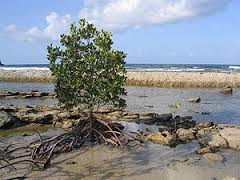Mangroves as Bio-Sheids Against Coastal Disasters
Coastal mangroves serve as vital bio-shields against natural disasters. Recent research marks their effectiveness in mitigating the impacts of tsunamis and flooding along India’s coastline. The study, conducted by a team from the Indian Institute of Technology Bombay, utilised advanced simulations to evaluate how emergent vegetation, particularly mangroves, acts as a protective barrier. This research puts stress on the importance of integrating natural solutions into coastal defence strategies.
Role of Mangroves in Coastal Protection
Mangroves are unique trees with complex root systems. They thrive in saline coastal environments. Their sturdy structures help dissipate wave energy during storms and tsunamis. Without mangroves, coastal areas would face greater destruction during such events. The presence of mangroves reduces the impact of debris on buildings and infrastructure.
Research Methodology
The research team employed a smoothed particle hydrodynamics (SPH) model. This computational technique simulates fluid dynamics and interactions between water, vegetation, and debris. The study replicated coastal conditions in a controlled environment, using a large water tank. The setup included a column representing a coastal building and debris models simulating shipping containers.
Findings on Debris Impact
The research revealed that heavier debris causes more impact forces on structures. The SPH simulations demonstrated that rigid staggered vegetation (RSV) outperformed tilting staggered vegetation (TSV) in reducing wave forces. RSV, akin to upright mangroves, effectively dissipated wave energy, while TSV showed less efficiency. The study recorded a 96% reduction in debris impact with rigid vegetation compared to 89% with tilting vegetation.
Implications for Coastal Defence
The findings suggest that planting rigid emergent vegetation along coastlines can mitigate erosion and protect against storm surges. Mangroves not only shield against disasters but also serve as carbon sinks, contributing to climate goals. Policymakers and coastal planners are encouraged to adopt nature-based solutions for sustainable coastal management.
Future Research Directions
Further studies are needed to assess the performance of various vegetation types under natural conditions. This includes examining different wave movements and debris materials. Advanced simulations could provide deeper vital information about the effectiveness of coastal vegetation in disaster mitigation.
Month: Current Affairs - February, 2025
Category: Environment Current Affairs








